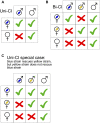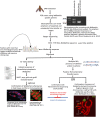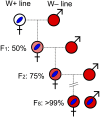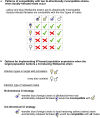Wolbachia pipientis Associated With Tephritid Fruit Fly Pests: From Basic Research to Applications
- PMID: 32582067
- PMCID: PMC7283806
- DOI: 10.3389/fmicb.2020.01080
Wolbachia pipientis Associated With Tephritid Fruit Fly Pests: From Basic Research to Applications
Abstract
Members of the true fruit flies (family Tephritidae) are among the most serious agricultural pests worldwide, whose control and management demands large and costly international efforts. The need for cost-effective and environmentally friendly integrated pest management (IPM) has led to the development and implementation of autocidal control strategies. These approaches include the widely used sterile insect technique and the incompatible insect technique (IIT). IIT relies on maternally transmitted bacteria (namely Wolbachia) to cause a conditional sterility in crosses between released mass-reared Wolbachia-infected males and wild females, which are either uninfected or infected with a different Wolbachia strain (i.e., cytoplasmic incompatibility; CI). Herein, we review the current state of knowledge on Wolbachia-tephritid interactions including infection prevalence in wild populations, phenotypic consequences, and their impact on life history traits. Numerous pest tephritid species are reported to harbor Wolbachia infections, with a subset exhibiting high prevalence. The phenotypic effects of Wolbachia have been assessed in very few tephritid species, due in part to the difficulty of manipulating Wolbachia infection (removal or transinfection). Based on recent methodological advances (high-throughput DNA sequencing) and breakthroughs concerning the mechanistic basis of CI, we suggest research avenues that could accelerate generation of necessary knowledge for the potential use of Wolbachia-based IIT in area-wide integrated pest management (AW-IPM) strategies for the population control of tephritid pests.
Keywords: cytoplasmic incompatibility; endosymbiont; incompatible insect technique; insect control; symbiosis.
Copyright © 2020 Mateos, Martinez Montoya, Lanzavecchia, Conte, Guillén, Morán-Aceves, Toledo, Liedo, Asimakis, Doudoumis, Kyritsis, Papadopoulos, Augustinos, Segura and Tsiamis.
Figures




References
-
- Aleksandrov I., Aleksandrova M., Goriacheva I., Roshchina N., Shaikevich E., Zakharov I. (2007). Removing endosymbiotic Wolbachia specifically decreases lifespan of females and competitiveness in a laboratory strain of Drosophila melanogaster. Genetika 43 1372–1378. - PubMed
-
- Apostolaki A., Livadaras I., Saridaki A., Chrysargyris A., Savakis C., Bourtzis K. (2011). Transinfection of the olive fruit fly Bactrocera oleae with Wolbachia: towards a symbiont-based population control strategy. J. Appl. Entomol. 135 546–553.
Publication types
LinkOut - more resources
Full Text Sources

